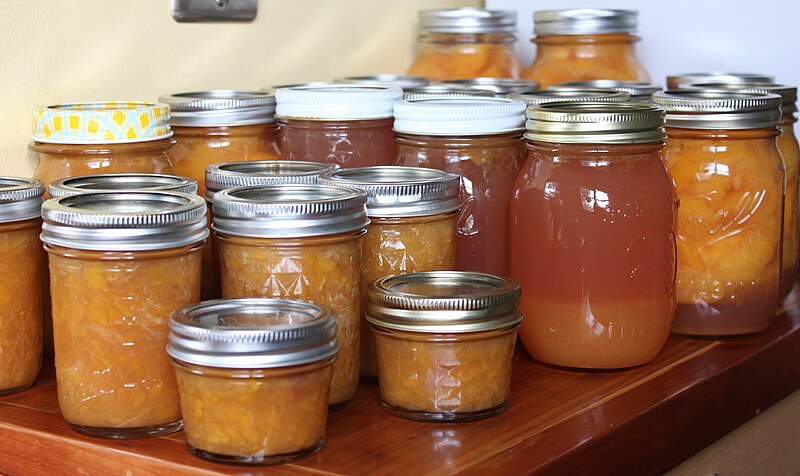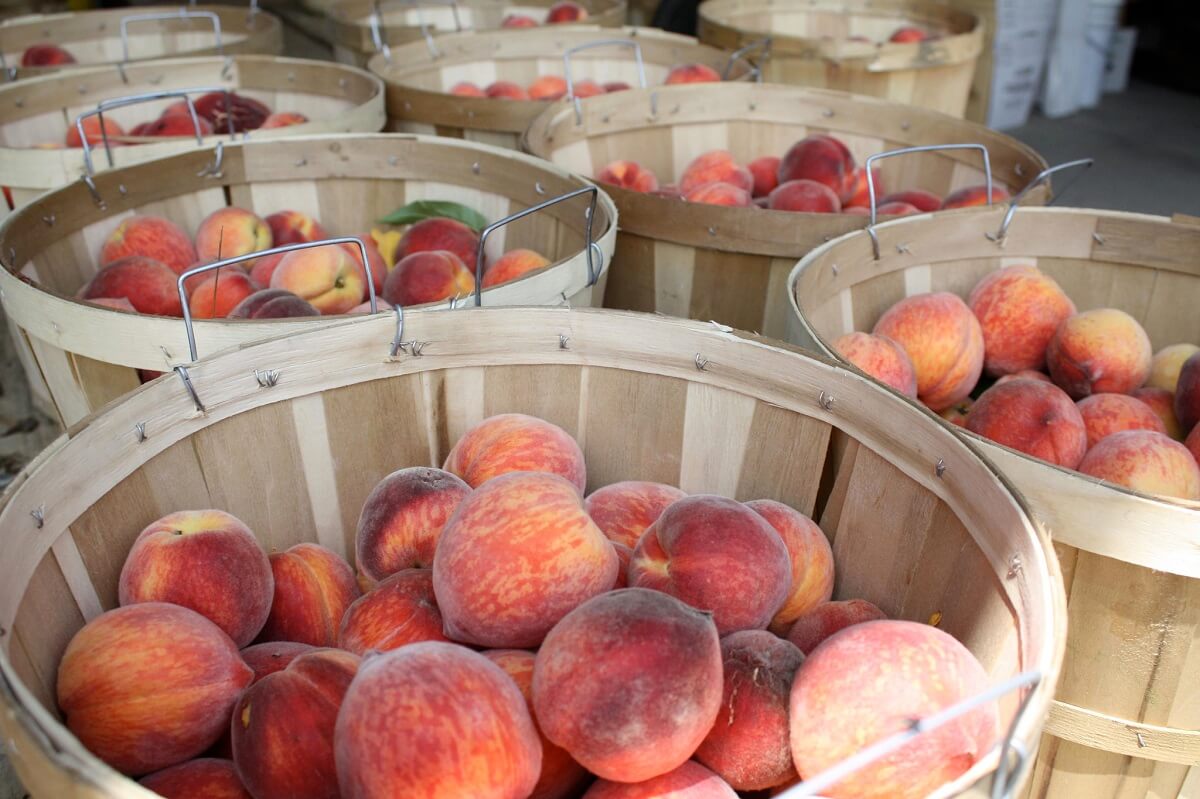After spending many memorable summers in the south, I am addicted to the smell and taste of peaches. Aunt Mildred and Uncle Elmer nurtured several different varieties in the peach orchard of their rural Georgia homestead.
I loved joining Auntie Millie and the cousins, picking, peeling, preserving, and putting up peaches. Although most of the crop was reserved for canning, Uncle made sure we saved the pits for crafting a big batch of his famous peach brandy.
What will you do with your peaches? There are many methods of preserving the goodness of peaches well past harvest time. If your homestead produces a surplus, its fun to let your imagination run wild when it comes to recipes.
You can never have too many jars of peaches on the shelves in the pantry and peach jam, chutneys, pickled peaches, peach salsa, peach syrup, peach pie filling, or jelly all make great gifts for family and friends.
Selecting Peaches For Canning
When selecting peach varieties for canning and preserving, freshness is the most important factor affecting flavor. All varieties of peaches, when allowed to ripen on the tree, taste remarkably better than store-bought.
Related Post: Dwarf Fruit Trees
Unlike some fruits, peaches do not continue to ripen after they are picked. They quickly soften and spoil due to bacterial and enzyme action which does nothing to enhance the sweetness, fragrance, or flavor of the fruit.

The best quality peaches present a tight, fresh looking skin. Select ripe, firm, organically-grown, tree-ripened peaches free of bruising, spoilage, or insect damage. Peach size does not indicate quality as early-season peaches tend to be smaller, but they are also the sweetest.
Freestone varieties are generally preferred for canning while clingstone variants are considered best for peach pickles, chutneys, or preserves.
Preparing Peaches For Canning
If you are planning on canning peaches, you will need approximately 18 pounds to fill 7 quarts. Seven 1-quart jars is generally the number you can process in a large canning kettle with a jar rack. If you use a rack for pint jars, you will need 12 pounds of peaches to fill 9 pints.
No matter whether you are canning the fruit, or making peach jams or jellies, you have to get rid of the skin and pits.
- Dip peaches in boiling water for 60-90 seconds or until skins loosen.
- Dip in ice water, and slip off the skin.
- Remove pits.
- Cut peaches in half, or slice as desired.
- To prevent darkening during preparation, place peeled peaches in a mild salt solution of 1 teaspoon of salt to a quart of water. As an alternative, you can use a prepackaged, ascorbic acid powder according to the directions on the label.
Aunt Millies Perfect Canned Peaches

In midwinter, opening a jar of canned peaches brings back all the sweetness and sunshine of summer.
Supplies And Ingredients
- Heavy-bottom saucepan
- Slotted ladle
- 7 1-quart canning jars, lids, and seals
- Canner
- Canning tongs
- 18 pounds of peaches
- 1 tsp. lemon juice (per quart jar)
- c. sugar (per quart jar)
Directions
- Place halved, peeled, and pitted peaches in a heavy-bottom saucepan.
- Add cup of granulated sugar and a teaspoon of fresh lemon juice per quart of peaches.
- Bring sugar, lemon juice, and peaches to a boil, stirring constantly. The peaches will create their own syrup.
- Reduce heat and simmer for 5 minutes.
- Using a slotted ladle, pack peaches in hot sterilized jars, overlapping layers, with the pit side down.
- Cover peaches with syrup to inch from the top of the jar.
- Wipe lids with a clean cloth dipped in boiling water, adjust lids and finger tighten bands.
- Place in the rack of a canning bath kettle.
- Cover jars with water, bring to a boil, and process for 20 minutes.
- Using canning tongs, remove jars from canner and invert on a dry towel-covered rack to cool overnight.
- Check that jars are properly sealed, and date and label for storage.
Best Ever Peach Brandy
In addition to adding a flavor boost to canned peaches, the pits are perfect for making some of the best peach brandy you will ever taste. All it requires is peach skins, pits, sugar, water, and patience.
This heavenly elixir is a great way to utilize all the pits and skins leftover from your canning efforts. For each quart jar of brandy, you will need about 15 to 20 peach pits, 2 cups of granulated sugar, and 2 cups of boiling water.
Supplies and Ingredients
- Heavy bottom saucepan
- Quart sized canning jars, lids, and bands
- 15-20 peach pits (per quart jar)
- Peach skins
- 2 c. granulated sugar (per quart jar)
- 2 c. boiling water (per quart jar)
Directions
- Bring sugar and water to a boil in a heavy bottom saucepan.
- Fill sterilized, hot jars with peach skins and peach pits.
- Pour sugar and water mixture over skin and pits to within inch of the top of the jar.
- Wipe lids with a clean damp cloth to remove drips and debris for a tight seal.
- Cover jars with hot, sterilized lids, add bands, and tighten.
- Place jars in the root cellar or a cool dark place and forget them.
- After six months of aging, the nectar is ready.
- Strain through cheesecloth before serving.
More Recipes For Your Peaches
If youve found yourself in the lucky position of having a whole lot of peaches on your hands, check out these delicious recipes featuring peaches.
Scotch Bonnet Peach Pepper Jam
When unexpected guests arrive, peach-pepper jam served with sliced age cheddar and crispy crackers are the perfect impromptu appetizer.
Hot And Zesty Pepper And Peach Spread
Served over cream cheese, this spicy peach and pepper spread is addictive. You will wish you made a double batch.
Georgia Peach Pound Cake
Perfect to share with friends over coffee, Georgia peach pound cake also makes a great gift.
Peach Information And History
Native to China and brought to the New World by Spanish traders, peaches also known as Persian apples (Prunus persica) are cultivated around the world. There are more than 300 varieties thriving in the United States with more than 2,000 different varieties found globally.
A member of the rose family, peaches, nectarines, plums, and cherries are considered stone fruits because they have a pit or stone.

Although the state of Georgia is known as the peach state and remains justifiably famous for the perfect peaches grown there, California grows the most peaches. Peaches flourish in USDA Plant Hardiness Zones 8 through 10. Peaches are a significant agricultural crop in California, Georgia, Colorado, North Carolina, South Carolina, Pennsylvania, Michigan, Washington, and New Jersey.
Peach Varieties
No matter how the thousands of varieties differ in taste, texture, color, shape, or size, they all fall into three main categories: freestone, semi-freestone, and clingstone.
Free Stone Peaches
Freestone peaches present firm flesh that is easily released from the pit. Freestone peaches have firm flesh, low sugar content, and mild flavor and are perfect for baking. They retain their firmness when cooked and the subtle peach flavor does not overpower the other ingredients in baked goods.
When it comes to choosing the best freestone peaches for canning, many experienced cooks consider June Gold to be the ideal choice. Other popular freestone peach varieties include Red Top, OHenry, and Elegant Lady.
Semi-Freestone
A hybrid cross between freestone and clingstone varietals, semi-freestone peaches have high sugar content, are extra juicy, and the firm flesh does not cling to the pit. Zee Lady, Sentinel and Heath Cling, and GaLa are widely cultivated semi-freestone variants.
Many folks choose semi-freestone peaches when they just want to bite into a juicy, fresh peach. Semi-freestone peaches feature bright ruby red flesh next to the pit and are attractive sliced in a salad or served fresh over vanilla ice cream.
Clingstone

Clingstone peach varieties derive their name from the fact that the ripe fruit flesh clings tenaciously to the pit. Ripening from late May through mid-August, Clingstone varietals boast a creamy yellow flesh that turns a bold red close to the pit.
Clingstones are great for making peach jam as they present a soft, juicy texture, bold taste, and high sugar content. Santa Rosa, Spring Prince, and Red Beauty are three of the juiciest and most flavorful clingstone peach varieties.
Yellow Or White Peaches
When one thinks of the color of a peach, most envision a juicy, sweet fruit with firm golden-yellow to orange skin and flesh streaked with red. Popular peaches with yellow flesh include Autumn Gold, Tropi-berta, OHenry, Red Baron, and Earligrande.
However, if you have never tasted a white peach, you are in for a special treat. Sweeter and juicier than yellow peaches, white peaches are hybrids of Asian peach varieties, and present firm white flesh and mouth-watering flavor. Popular white peach tree cultivars include White Lady, Arctic Supreme, Bella George, Babcock, Belle of Georgia, Polly and White Nectar.
A Note On White Peaches
Do not attempt to process, preserve, or can white-flesh peaches. Most varieties of white-flesh peaches have a high pH, thus are low in acid. There is no safe low-acid method for pressure processing or water-bath canning of white-fleshed peaches. If you have white-fleshed peaches you wish to preserve, throw them in the freezer.
References:
- Peaches, Wisconsin Department of Public Education
- Complete Guide to Home Canning, United States Department of Agriculture
- Selecting, Preparing and Canning Fruit Peaches Halved or Sliced, National Center for Home Food Preservation
- Ways With Peaches, LSU AgCenter
- Preserving Peaches: Canning, Freezing, Jam or Salsa, Clemson Cooperative Extension



 #homemade #peachbrandy #lazysunday
#homemade #peachbrandy #lazysunday . . Any pound cake fans? What's your favorite flavor? (Comment below)
. . Any pound cake fans? What's your favorite flavor? (Comment below) 
 . . . #poundcake #peachpoundcake #peach
. . . #poundcake #peachpoundcake #peach